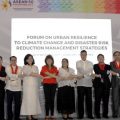As a customer-first telecommunications company, Globe works hard to make key network products and services available despite natural disasters and widespread calamities through its Business Continuity Management System (BCMS).

The telco is dedicated to ensuring the efficiency of the BCMS and the maintenance of its enterprise-wide ISO 22301 certification, the international standard for business continuity management, security and resilience.
In preparation for unforeseen events and calamities, Globe has ready-to-deploy and flexible solutions that provide communications services in pre-defined government command centers and safe operating zones. These include equipment such as Cell Site on Wheels (COW) and Tower on Wheels (TOW) that can handle up to 1,000 simultaneous calls within a 3-5 kilometer radius. Globe also makes use of a complete mobile cell phone network system called Cellular-on-a-Light-Truck (COLT) which is powered by mobile generators. Innovative solutions such as the Network-in-a-Box (NIB) and the deployable Mobile Command Center (MCC) have furthermore been introduced to reinforce operations.
The NIB is an actual cell site that serves a considerable number of subscribers and can be easily carried like a backpack by personnel, while the MCC allows for tactical roles to be performed in managing resources on ground.
In addition to having a backup network, Globe also supports the national government in its rescue operations by deploying emergency equipment and Globe personnel to disaster areas by land and air.
The company simultaneously collaborates with the National Disaster Risk Reduction and Management Council (NDRRMC) to send out geo-tagged disaster-related SMS alerts and cell broadcasts to its customers as required by Republic Act 10639, otherwise known as “The Free Mobile Disasters Alert Act”.
This is in addition to Globe’s partnerships with local government units, trade distributors, and communities across the Philippines for the provision of free calls, texts, charging, and internet connectivity in disaster-affected areas.
To prepare for tropical cyclones, Globe continues to redesign and retrofit its towers along the typhoon path to comply with the latest National Structural Code of the Philippines. Globe has also equipped key sites which were identified as “first to recover and last to be disrupted”, with relevant access technologies and redundant transport facilities in the event of area-wide outages.
“Globe’s business continuity management framework is integral to our operational resilience and excellence. This resilience of our people, processes and infrastructure allows the company to respond effectively to disasters, limit service disruptions and deliver speedy recovery of operations. Communications systems are even more critical during a crisis, especially since our subscribers rely on our products and services for key day-to-day activities. Our continued investments in risk management systems have assured that our network will be up and running when needed the most,” said Rizza Maniego-Eala, Globe Chief Risk Officer.
Globe furthermore maintains an Emerging Infectious Disease Policy to ensure the delivery of services in the event of a future pandemic. This proved most useful as part of the Business Continuity Management framework at the onset of the COVID-19 pandemic.
The World Economic Forum’s Global Risks Report 2020 confirmed that extreme weather events and climate action failure are among the top ten risks to the global economy in terms of likelihood and impact. Given the severity of these risks, Globe’s BCM system continues to play a vital role in maintaining the reliability of its activities and services.
The BCMS is part of Globe’s commitment to the United Nations Sustainable Development Goals such as UN SDG No. 11—Sustainable Cities and Communities—which highlights the importance of making cities inclusive, safe, resilient, and sustainable. It also calls for a holistic disaster risk management at all levels in line with the Sendai Framework for Disaster Risk Reduction 2015-2030 through the integration of policies and plans towards inclusion, resource efficiency, mitigation and adaptation to climate change, and resilience to disasters.






